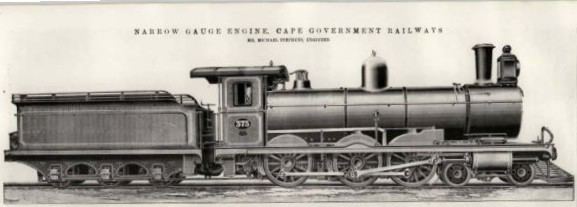In service 1896-1898 | Configuration 3-axle | |
 | ||
Locomotive CGR 6th Class of 1896CGR 6th Class of 1898OVGS 6th Class L2 Builder Dübs and CompanyNeilson and CompanyNeilson, Reid and CompanySharp, Stewart and Company Gauge 3 ft 6 in (1,067 mm) Cape gauge | ||
The South African type YC tender was a steam locomotive tender from the pre-Union era in the Cape of Good Hope.
Contents
The Type YC tender first entered service in 1896, as tenders to the second version of the 6th Class 4-6-0 Tenwheeler type steam locomotives to be acquired by the Cape Government Railways. These locomotives were designated Class 6A on the South African Railways in 1912.
Manufacturers
Type YC tenders were built between 1896 and 1898 by Dübs and Company, Neilson and Company, Neilson, Reid and Company and Sharp, Stewart and Company.
The original 6th Class locomotive and tender had been designed at the Salt River works in Cape Town in 1892, under the supervision of Western System Locomotive Superintendent H.M. Beatty. In 1896 and 1897, the Cape Government Railways (CGR) placed a second batch of fifty 6th Class 4-6-0 locomotives in service, which would be designated Class 6A on the South African Railways (SAR) in 1912.
The Type YC first entered service as tenders to these locomotives. More entered service in 1896, as tenders to the Oranje-Vrijstaat Gouwerment-Spoorwegen (OVGS) 6th Class L2, and in 1898, as tenders to the CGR 6th Class of 1898.
Characteristics
The tender, as built, had a coal capacity of 5 long tons 10 hundredweight (5.6 tonnes), a water capacity of 2,590 imperial gallons (11,770 litres) and an average maximum axle load of 10 long tons 8 hundredweight (10,570 kilograms).
Locomotives
In the SAR years, tenders were numbered for the engines they were delivered with. In most cases, an oval number plate, bearing the engine number and often also the tender type, would be attached to the rear end of the tender. During the classification and renumbering of locomotives onto the SAR roster in 1912, no separate classification and renumbering list was published for tenders, which should have been renumbered according to the locomotive renumbering list.
Three locomotive classes were delivered new with Type YC tenders. Bearing in mind that tenders could and did migrate between engines, these tenders should have been numbered in the SAR number ranges as shown.
Classification letters
Since many tender types are interchangeable between different locomotive classes and types, a tender classification system was adopted by the SAR. The first letter of the tender type indicates the classes of engines to which it could be coupled. The "Y_" tenders could be used with the following locomotive classes:
The second letter indicates the tender's water capacity. The "_C" tenders had a capacity of between 2,590 and 2,600 imperial gallons (11,770 and 11,820 litres; 3,110 and 3,122 US gallons).
Modification
The original slatted upper sides of the tender's coal bunker were often replaced by sheet-metal sides. Some Type YC tenders were fitted with new tanks and modified to increase their coal capacity from 5 long tons 10 hundredweight (5.6 tonnes) to 7 long tons 10 hundredweight (7.6 tonnes). The new tank was slightly bigger, which increased the water capacity from 2,590 to 2,600 imperial gallons (11,770 to 11,820 litres). The maximum average axle load of the modified tender was 11 long tons 1 hundredweight 2 quarters (11,250 kilograms).
